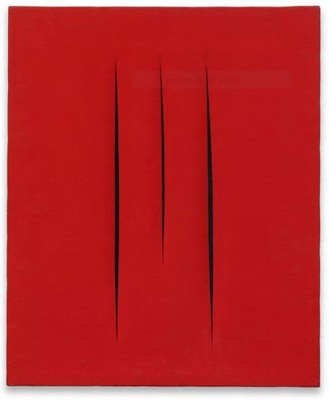Color Form
Lévy Gorvy Dayan & Wei, Hong Kong
March 21 – May 31, 2024
Concetto spaziale, Attese, 1968
Water-based paint on canvas
24 × 19¹¹⁄₁₆ inches (61 × 50 cm)
Courtesy Lévy Gorvy Dayan & Wei
Peinture 101 x 130 cm, 16 août 2015
Acrylic on canvas
39¾ × 51³⁄₁₆ inches (101 × 130 cm)
Courtesy Lévy Gorvy Dayan & Wei
Lévy Gorvy Dayan & Wei presents Color Form, an exhibition that delves into the two fundamental building blocks of painting—color and form—the two properties that lie at the heart of the medium’s potential. For modern physicists, color is seen as the eye’s perception of light waves of different frequencies—while form relates to the shape of matter. In science, as in art, the precise nature of this intrinsic relationship between light, energy, and matter is veiled. For artists, the creative relationship between form and color is one that has been explored intuitively ever since the first cave paintings made over 40,000 years ago.
It is no accident that during the modern Atomic Age of the 1950s and ’60s—when the elemental nature of the relationship between light, energy, and matter had been made evident to all mankind— many painters began to focus uniquely on form and color in their work: elevating these two central components as the sole protagonists of their art. In America, this marked the period of color-field painting, with artists like Mark Rothko and Barnett Newman creating large-scale canvases filled with blocks of emotive, abstract color. In Europe, another type of color-form painting also became a mainstay of various avant-garde artists from Pierre Soulages and Alberto Burri, to Lucio Fontana and Zao Wou-Ki.
From the 1950s onward, each of these artists used their own modes of color-form abstraction to explore the intrinsic relationship between light, energy, space, and matter. For Pierre Soulages, as his Outrenoir (“beyond-black”) paintings reveal, the concentration on black pigment allowed for the discovery of illumination and light. “My instrument is not black,” Soulages insisted “but the light reflected from the black.” His works including Peinture 101 x 130 cm, 16 août 2015 and Peinture 309 x 181 cm, 12 décembre 2013, exemplify his ethos: “I found that the light reflected by the black surface elicits certain emotions in me. These aren’t monochromes. The fact that light can come from the color which is supposedly the absence of light is already quite moving, and it is interesting to see how this happens.” By applying paint in dense, material layers and using varied tools as well as brushes to generate smooth and rough surfaces, Soulages created surface textures that absorbed or emitted light. “Rather than movement, I prefer to talk of tension,” Pierre Soulages said, “and rhythm, yes. We can also say form: a shaping of matter and light.”
While Pierre Soulages made use of monochromatic fields of black to portray light, Italian artists such as Alberto Burri and Lucio Fontana took monochrome painting in other directions. For Alberto Burri, planes of single hues, as seen in Nero Cellotex (1986–87) became a means of exploring the innate nature and self expressive potentials of painted matter—while for Fontana, monochromatic tone was a vehicle for the articulation of deeper understandings of cosmic space.
In his investigations of space, including his Attese works, and Concetto spaziale, Attese (1968) in particular, Lucio Fontana destroyed the material surface of the canvas with a slash of a knife, opening up the saturated red picture plane to the embracing voids of space. In so doing, he created a painting that unites form, color, material, and space through his decisive gestures. A similar use of spontaneous energy to form painterly matter underpins the pictorial abstraction of Chinese artists like Zao Wou-Ki and Chu Teh-Chun, who, working in Paris from the 1950s onwards, sought to meld traditional Chinese painting with the color-form explorations of Western abstraction.
By contrast, Pat Steir’s Waterfall series reflects the attempts of an American-born artist to draw inspiration from Eastern approaches to color and form. Deeply influenced by Chinese literati paintings, Zen Buddhism, and the example of John Cage, Pat Steir’s work, exemplified by Another Place (2017), investigates the aesthetic potentials of chance, gravity, and the weight of pigment to generate a painting’s ultimate form. Pat Steir has said, “The way colors mix and the way they touch each other explains the world to me like mathematics explains the world to a physicist.”
LÉVY GORVY DAYAN & WEI
G/F, 2 Ice House Street, Central, Hong Kong


